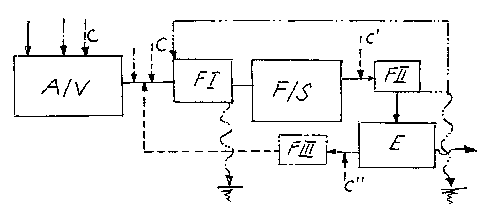Note: Descriptions are shown in the official language in which they were submitted.
1 3 ~ 7
SYSTEM FOR WASTEPAPER CONDITIONING
The invention concerns a system for wastepaper conditioning
(deinking) of wastepaper with several successively arranged
cleaning stages of which one comprises a multiple stage
flotation system, also through direct sequential arrangement
of individual flotation cells, and where a further separation
of dirt takes place in another flotation system. Such a
system is known from the German Patent Disclosure 28 13 448.
In this system, the deckering water accruing in the concentrator
is selectively cleaned of the dirt it carries in another
flotation system.
Similarly, according to "Wochenblatt fur Papierfabrikation"
1976, page 780, wash filtrate of a system for wastepaper
conditioning is clarified in so-called flotation substance
catchers using the flotation principle. These flotation
apparatuses, for instance pursuant to "Da~ Papier", 1975, page
V 159, operate practically without turbulence so that all
floating substances contained in the wash filtrate are being
separated, for one downwardly by sedimentation and for another
upwardly by flotation. All that remains in the filtrate is
practically only a very small, negligible portion of these.
In this way, the clarified wash filtrate can be recycled in
the circuit as wash water. This is a relatively commonplace
measure, since wasting water through unnecessarily high water
consumption must be avoided, whereas on the other hand also
relatively clean water is to be used for washing. A similar
system is knows also from ~'Paper Technology", pages 282-283.
. r
~ ~ -2- 1 3351 47
The problem underlying the invention is to improve by flotation the dirt
separation in the wastepaper suspension, that is, in the major circuit. This problem is
inventionally solved by the features of the present invention.
Suitable as first ~otation stage is especially a flotation cell equipped with at the
most a few large injectors, for instance, according to the German Patent Disclosure
31 44 387 (published May 19, 1983). Suitable for the flotation setup of the second
flotation process stage are cells with a dispersing wheel according to U.S. Patent
No. 4,267,052 or flotation cells with very many injectors using the design according
to British Patent Application 2,042,788 (published September 17, 1980). It yields a
relatively small bubble size at a relatively low ratio of air quantity to suspension
quantity.
Dividing the flotation in at least two processing stages accomplishes that a
maxin~ separation of the substances to be removed by flotation can take place in
accordance with their characteristic flotation features. Relatively large dirt is
separated best by a ~otation of great turbulence and with large air bubble diameters
while relatively small dirt or such with low hydrophobia is separated best by a
flotation with little turbulence.
The invention will be explained hereafter with the aid of embodiments
illustrated in the drawings.
Fig. 1 is a schematic diagram of a wastepaper conditioning system in
accordance with the present invention.
Fig. 2 is a schematic diagram of another embodiment of a wastepaper
t'~ conditioning system.
1~
_3_ l 335 1 47
Illustrated in Fig. l i~ a dual ~tage flotation, where A
means dissolution, V presorting, F I thQ flotation proc~ss
stage I with high turbulence, which may comprise also multiple
stages, F fine cleaning, 5 sorting, F II the flotation process
stage II with relatively little turbulence and very fine air
bubbles, which may comprise also multiple stages, and E a
deckering stage. These abbreviations apply also to Fig. 2.
These treatment steps are arranged in the main circuit, with a
side circuit indicated by broken line that contains a third
type F III flotation stage with a very calmed flotation, for
instance clarification flotation, that can be likened to a
sedimentation and by which filtrate water of the deckering
stage can be cleaned further. A relatively large amount of
air is used in the flotation stage F I, so that the ratio of
air amount L to the total weight of suspension G, based on dry
substance (otro), meets the following condition: 30 ~ L/G ~ 100%
The air bubble size should be so selected that at least 80% of
these will be greater than 1 mm in diameter. Considerably
smaller air bubbles and also a considerably smaller quantity
of air, according to the condition ~/G ~ 30~, are used in the
flotation stage F II. The air bubble si2e should be so
selected that at least 60~ of these will be less than 1 mm in
diameter, and more preferably at least 80t will be les3 than 1
mm in diameter. Indicated additionally, by arrows C, C' and
C'', is the addition of chemicals for the various process
steps. The broken-line arrows mean the addition of water.
The cleaning and sorting stages V, F and S are consistent with
those of usual systems, such as following, e.g., from the
mentioned "Paper Technology", page 282, Fig. 1, and from the
German Patent Publication 26 10 581, Fig. 1.
_4_ 1 335 1 47
In the system according to Fig. 2, the deckering E
including a di~per~ion apparatu~ D is arranged before the
flotation stage F II. Provided after the flotation stage F II
is a second deckering stage that is accompanied by a bleaching
B. The wastewater of both deckering stages is cleaned as well
by a flotation stage F III. Here, too, the flotation stage F
III is of the type of the same stage relative to Fig. 1.
Instead of discarding the flotation rejects from stage F
II, they may be recycled also to the first flotation stage F I
according to the double dot/dash line.
_
-
